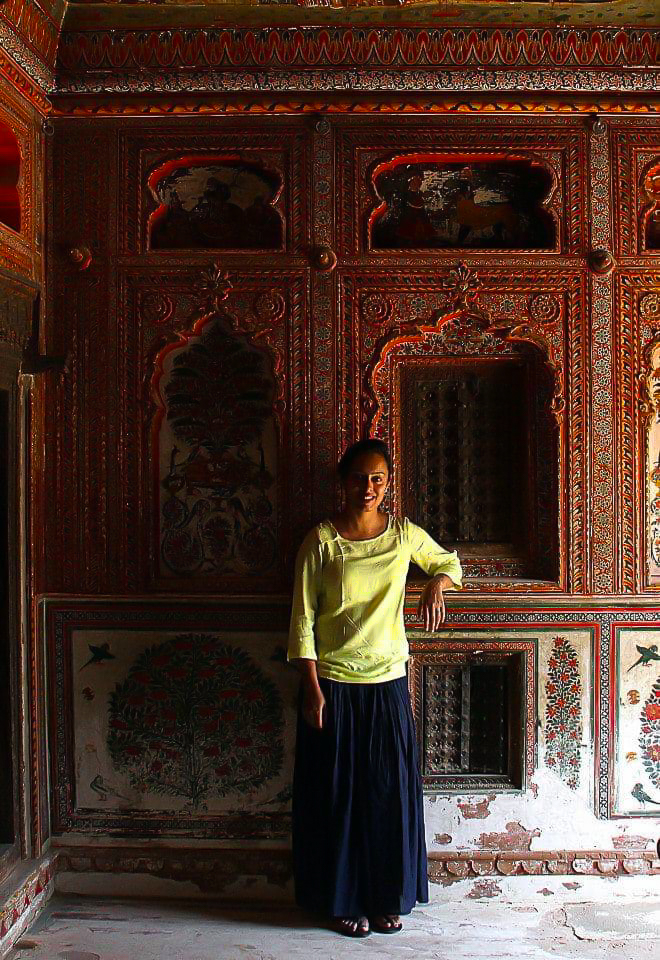I visited Mahansar on a half-day trip from Mandawa. That was the second Shekhawati town, I explored in Rajasthan and Mahansar turned out to be another dusty little obscure Shekhawati village, like Mandawa. Once, a prosperous Silk Route trading town, over time, Mahansar slipped through the cracks of history. At present, its sole claim to fame nowadays was the stunning Sone Chandi ki Dukan.
Table of Contents
The rise and fall of the fate of Mahansar
Founded by Nawal Singh in 1768, Mahansar, just like the rest of the Shekhawati trading towns, flourished economically for several decades, and one of its wealthiest patrons, the Poddar clan left behind a string of gem-like painted havelis. Mahansar’s fate overturned when one of the Poddars lost his livelihood and his two shiploads of opium sank in the ocean, leaving him penniless. Mahansar, along with its mercantile patrons slipped into obscurity and the village in present days produces famous home-brewed alcohol. Popularly known as the Mahansar Liquor, this humble tipple enjoys much recognition in nearby states, and under the patronage of Rajendra Singh Shekhawat (8th generation scion of a Mahansar family), it participated in many international trade fairs.
Recommended Read: The painted havelis of Shekhawati

The ceiling of the Sone Chaandi ka Dukaan in Mahansar
The Sone Chandi ki Dukan is made of pure gold leaves
I spent approximately one hour at Mahansar and the entire time was dedicated to the magnificent Sone Chandi ki Dukan. The other attractions of Raghunath Mandir and Sahaj Ram Poddar Chatri were easy to miss and I headed straight to the massive haveli which had the gold-silver shop tucked away at its ground level. Till today, I cannot forget the gasp that escaped from my lips at the first sight of the famous attraction and the hall was definitely a sight to behold. Imagine a set of rooms painted from top to bottom with liquid gold and crushed gems in arid, dusty surroundings like Shekhawati. Sone Chandi ki Dukan created such a shock value and its contrast with the surroundings heightened the effect further.
Suggested Read: The havelis of Mandawa

A detail from the Sone Chandi ka Dukaan in Mahansar
The head-spinning contrast of the artistic wealth of Mahansar with its squalor
While, outside in the blazing afternoon heat, skinny street dogs panted in the shade and mangy crows scavenged rubbish heaps, inside the Sone Chandi ki Dukan, I was surrounded by intricate paintings which incorporated tiny gold leaves. I had a funny feeling of having fallen down Alice’s magic hole, as rustic barbers snipped mustaches, their scissors clicking busily at makeshift shops while Hindu gods swirled around me in precious reds and golds. The three vaulted ceilings of the haveli in Mahansar depicted scenes from the Ramayana, incarnation stories of Vishnu, and lifestyle of Lord Krishna and despite their age, which dated back to 1846, the frescoes were thankfully, beautifully preserved.

Here are some glimpses of Mahansar’s rich history.
Do you think the Shekhawati heritage can be preserved?
Here and there ornate carved wooden lintels, flouncy peacocks, and parrots with ruby red beaks gave glimpses of wooden storage chests. Being protected from natural and human elements due to their architectural style, the halls of Sone Chandi ki Dukan reflected the Shekhawati grandeur in its truest form. It was the best finale of a rather strange day and I left Mahansar with a happy heart. All was not as bad as my first impression of Shekhawati, and perhaps the heritage of the painted havelis might have a chance of survival.

Sone Chandi ka Dukaan has frescos decorated with gold.
Mahansar Travel Tips
How to Reach Mahansar
Mahansar is well connected by rail and road. The nearest towns in Rajasthan are Churu (18 KM) and Jhunjhunu (40 KM). Churu is directly connected with New Delhi through trains and the nearest airport is Jaipur International Airport (250 KM).
Mahansar Attractions
The Mahansar fort, Narayan Niwas Palace, dancing hall of Tolaram Haveli, various cenotaphs, Raghunath Temple, and Sone-Chandi Ki Dukaan are the famous places to visit in Mahansar. The frescoes of the Sone Chandi Ki Dukan have been painted with shimmering gold leaf and the scenes from the Ramayana in the southern section of the ceiling in the first chamber seem to glow due to the intensive gold adornment. The lower walls are richly embellished with floral and bird motifs, butterflies, fruit-laden trees, and flowers. On the northern side of the ceiling, the life of Krishna is portrayed along with various mythological depictions made in the inner roof. The timings of the Sone Chandi ki Dukan are 7 AM to 5 PM and the ticket costs 100 INR. Tickets are either sold at the site or at the shop in front of Raghunath Temple. The royal fort operates as a heritage hotel.

The mute havelis display Shekhawati’s importance and wealth from the Silk Route days.
A unique Mahansar souvenir
Mahansar has a rich heritage liquor brewing tradition and its main tipple is the Royal Heritage Liquor. The royal scions Mr. Rajendra Singh Shekhawat has kept the traditional drink alive by preserving the age-old royal recipe. Today the Mahansar brew is produced under the Heritage Liquor brand and is purely made from herbal produces, ghee, and dry fruits.

Sone Chandi ka Dukaan has frescos decorated with gold.

The rest of Mahansar looks like this.

The inner courtyard of Sone Chandi ka Dukan haveli.

Some Shekhawati havelis are unfortunately very dilapidated.

A mural of Raas Lila in one of the stunning painted havelis of Shekhawati

The painted Sone Chaandi ka Dukaan

Has some very intricate details

That depict mythological stories

From the Hindu epics.

The murals also showcase

Portraits of the owners

And all their aspirations.

Today, these stunningly painted mansions

Of the billionaires

Are what remains of Shekhawati past glory.
Follow the rest of the Shekhawati series
RESPONSIBLE TRAVELING-BECAUSE I CARE

